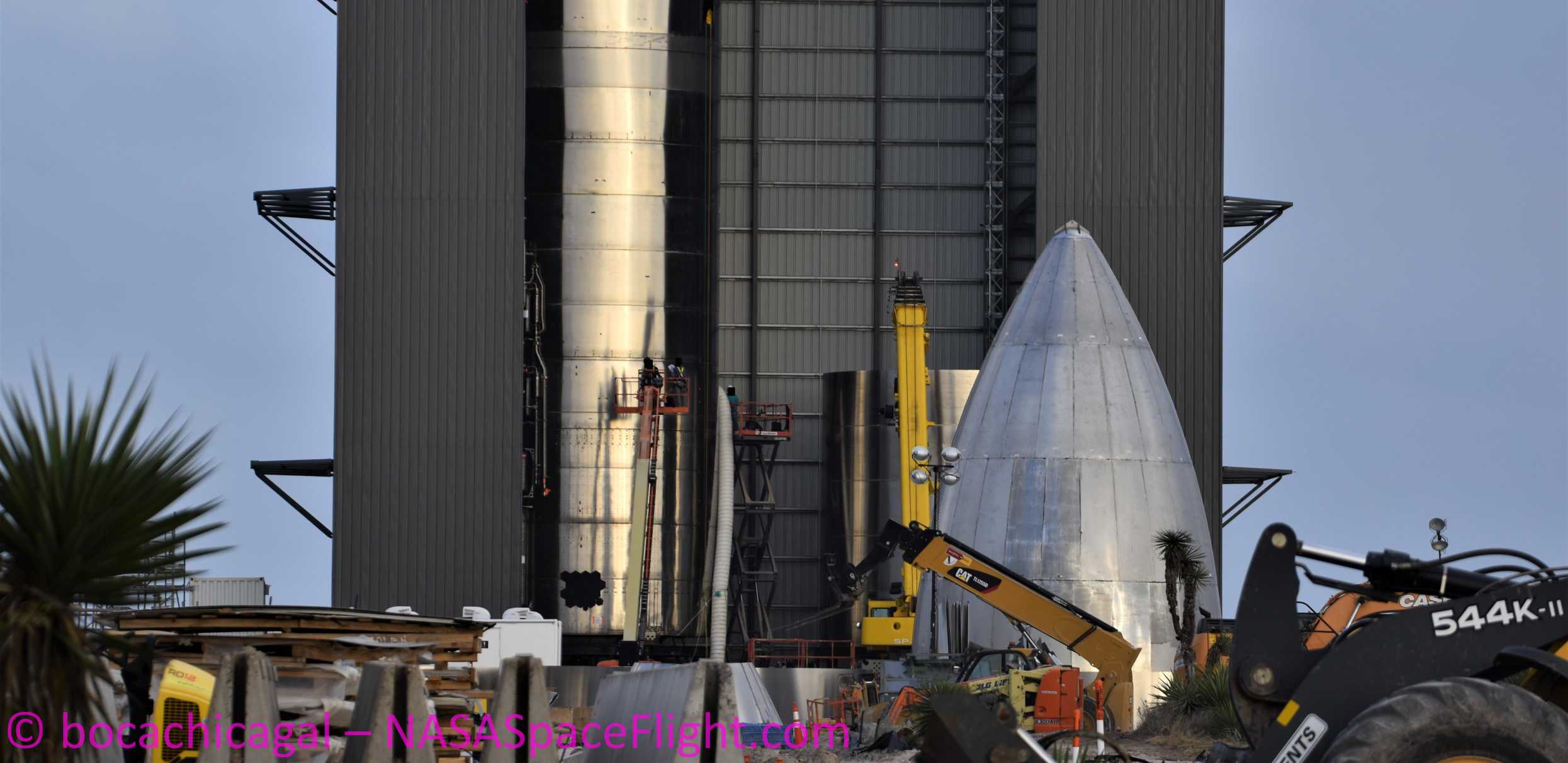

News
SpaceX Starship rocket set to reach full height for the second time ever
A SpaceX Starship prototype is on track to become the first to reach its full, operational height in a permanent fashion, following in the footsteps of a much earlier prototype that had its nose section temporarily installed last year.
Known as Starship Mk1, that prototype served as more of a learning experience, pathfinder, and mockup over the ~8 months it took to build it and the few weeks it took to destroy it. While its conical nose section was partially outfitted with smaller ‘header’ propellant tanks, it was never fully installed, with SpaceX only temporarily stacking it on top of Starship Mk1’s tank section to serve as the centerpiece of CEO Elon Musk’s October 2019 update event. Mk1’s nosecone was removed shortly after the event was over, while the rocket’s more important tank section was rolled to a nearby launch pad for testing.
More than six months later, Starship SN5 appears to be firmly on its way to becoming the first of SpaceX’s next-generation launch vehicle prototypes to have a (mostly) functional nose section permanently installed. If that ends up being the case, SpaceX’s fifth full-scale Starship prototype may become the first to have multiple Raptor engines installed and the first to perform a high-altitude flight test. Of course, that will depend quite heavily on the fate of Starship SN4, currently trapped in limbo after a May 19th static fire caused SpaceX to partially lose control of the rocket.
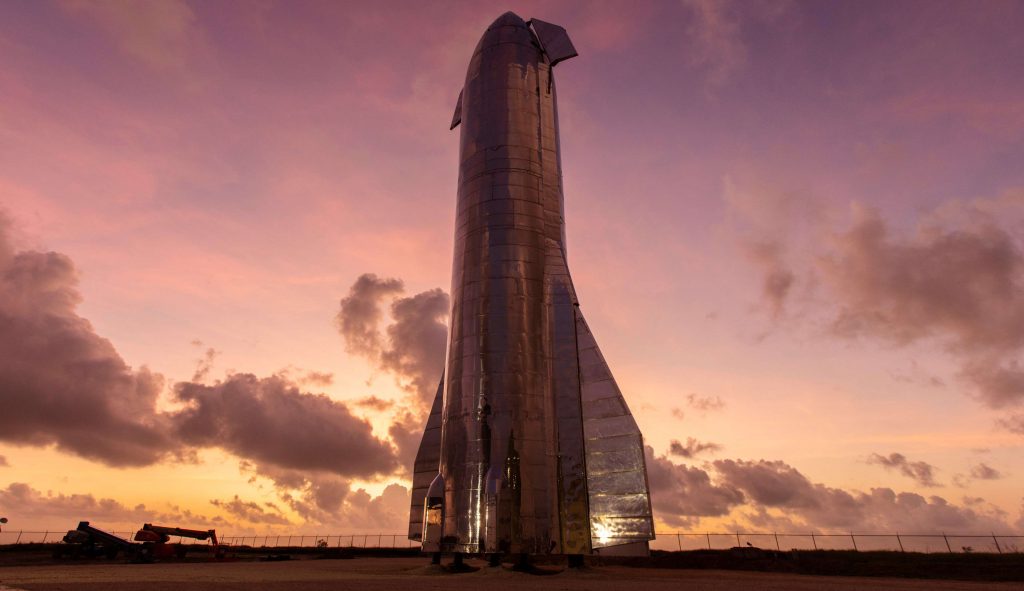
While not immediately clear, comments made by CEO Elon Musk and SpaceX officials suggested that the company was aiming to perform low-altitude hops with Starship SN4 and graduate to high-altitude testing with the next prototype off the assembly line (SN5). With a development program as agile as SpaceX’s Starship effort, however, plans are liable to change at almost any moment.
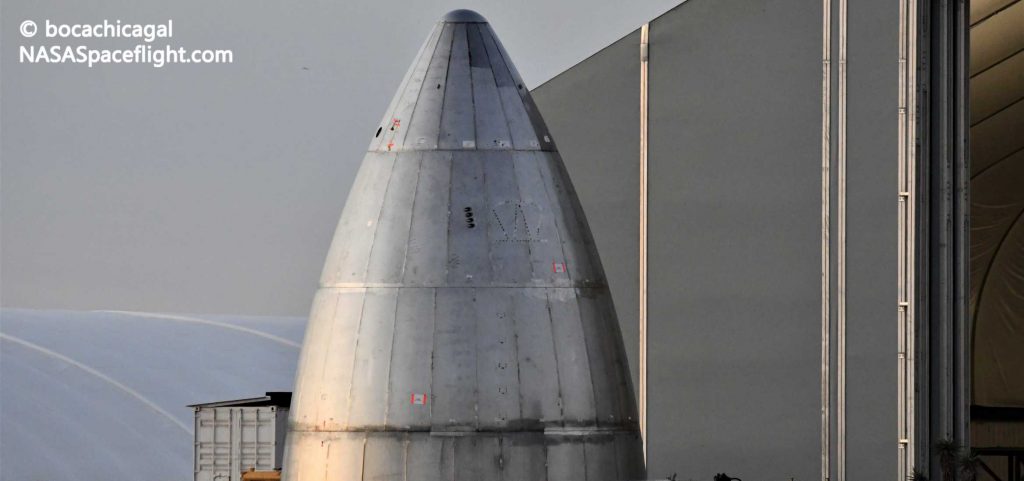
On May 17th, however, it became clear that – at least for the time being – SpaceX fully intends for Starship SN5 to become the first serially-produced ship to have a nosecone installed. On that Sunday, a brand new steel nose section – the fourth built by SpaceX in the last few months – was rolled out of a massive factory tent, revealing labels that rather unambiguously read “SN5”.
SN5 refers to Starship serial number 5, the fifth full-scale rocket prototype overall and fourth built since the start of 2020. Over the last six or so months, SpaceX has dramatically expanded its production footprint in South Texas, reaching a point now where it’s churning out a rough Starship prototype every month, on average. Starship SN5 is no different, with its tank section largely completed as of May 15th, give or take a day or two.
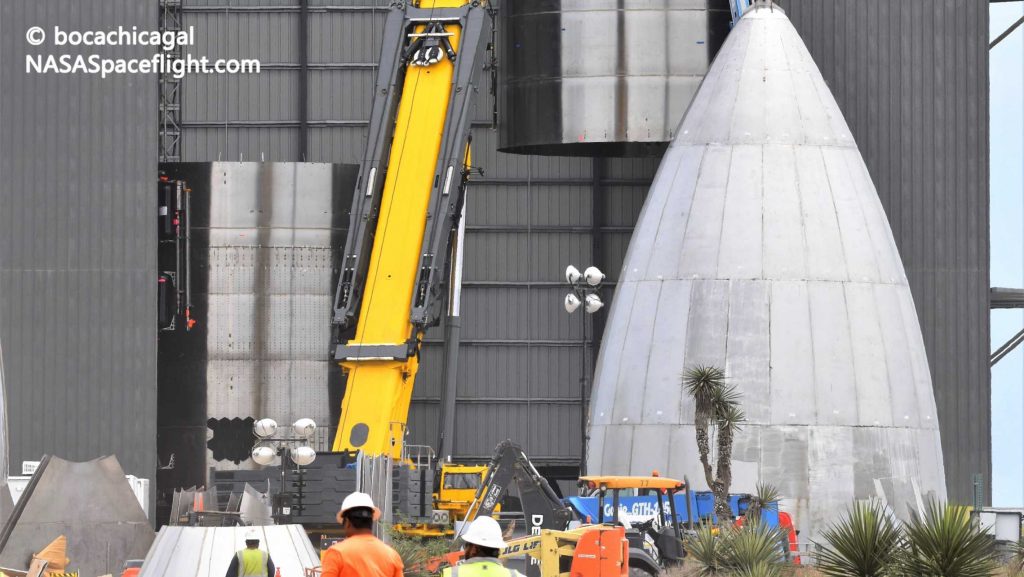
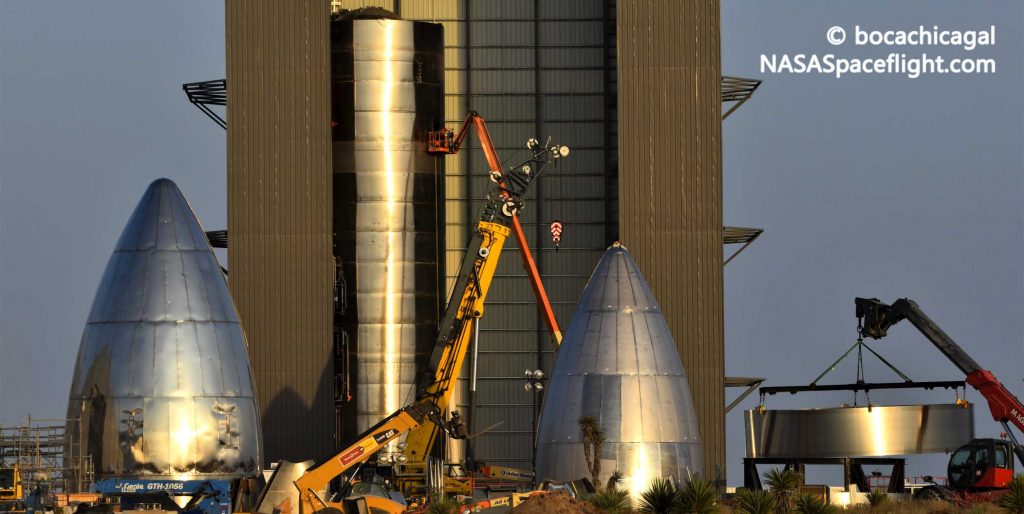

Now, on May 19th, a new collection of five stacked steel rings appeared alongside Starship SN5’s largely completed tank and engine section. Combined with the new nosecone labeled “SN5”, it’s now readily and unequivocally apparent that the prototype is probably a matter of days away from having a nosecone installed. Unless SpaceX has adopted different methods for Starship SN6 production and assembly, a stack of five steel rings – lacking any sign of a tank dome welded inside it – will serve as the base that SN5’s nosecone can be stacked on top of. Once stacked with its nose section, Starship SN5 will measure some 50m (~165 ft) tall – at least several meters taller than a Falcon 9 booster.

The nosecone itself is also quite interesting, featuring two sets of four mysterious thruster nozzles, signs of interior components and reinforcements, and two recessed struts presumably meant to attach to Starship’s forward flaps.
While exciting, there is certainly still a chance that Starship SN4 – trapped at the launch pad – will have to be destroyed or will be unsalvageable even if SpaceX is able to finally access and safe the prototype. If so, Starship SN5 will likely take its place, performing a Raptor static fire, a ~150m (~500 ft) hop test, and an additional ~3 km (~1.9 mi) flight test before potentially moving on to triple Raptor operations and high-altitude flights. Stay tuned for updates on SN4’s fate and SN5’s production status.
News
Tesla begins Robotaxi certification push in Arizona: report
Tesla seems serious about expanding its Robotaxi service to several states in the coming months.

Tesla has initiated discussions with Arizona transportation regulators to certify its driverless Robotaxi service in the state, as per a recent report from Bloomberg News. The move follows Tesla’s launch of its Robotaxi pilot program in Austin, Texas, as well as CEO Elon Musk’s recent comments about the service’s expansion in the Bay Area.
The Arizona Department of Transportation confirmed to Bloomberg that Tesla has reached out to begin the certification process for autonomous ride-sharing operations in the state. While details remain limited, the outreach suggests that Tesla is serious about expanding its driverless Robotaxi service to several territories in the coming months.
The Arizona development comes as Tesla prepares to expand its service area in Austin this weekend, as per CEO Elon Musk in a post on X. Musk also stated that Tesla is targeting the San Francisco Bay Area as its next major market, with a potential launch “in a month or two,” pending regulatory approvals.
Tesla first launched its autonomous ride-hailing program on June 22 in Austin with a small fleet of Model Y vehicles, accompanied by a Tesla employee in the passenger seat to monitor safety. While still classified as a test, Musk has said the program will expand to about 1,000 vehicles in the coming months. Tesla will later upgrade its Robotaxi fleet with the Cyercab, a two-seater that is designed without a steering wheel.
Sightings of Cybercab castings around the Giga Texas complex suggests that Tesla may be ramping the initial trial production of the self-driving two-seater. Tesla, for its part, has noted in the past that volume production of the Cybercab is expected to start sometime next year.
In California, Tesla has already applied for a transportation charter-party carrier permit from the state’s Public Utilities Commission. The company is reportedly taking a phased approach to operating in California, with the Robotaxi service starting with pre-arranged rides for employees in vehicles with safety drivers.
News
Tesla sets November 6 date for 2025 Annual Shareholder Meeting
The automaker announced the date on Thursday in a Form 8-K.

Tesla has scheduled its 2025 annual shareholder meeting for November 6, addressing investor concerns that the company was nearing a legal deadline to hold the event.
The automaker announced the date on Thursday in a Form 8-K submitted to the United States Securities and Exchange Commission (SEC). The company also listed a new proposal submission deadline of July 31 for items to be included in the proxy statement.
Tesla’s announcement followed calls from a group of 27 shareholders, including the leaders of large public pension funds, which urged Tesla’s board to formally set the meeting date, as noted in a report from The Wall Street Journal.
The group noted that under Texas law, where Tesla is now incorporated, companies must hold annual meetings within 13 months of the last one if requested by shareholders. Tesla’s previous annual shareholder meeting was held on June 13, 2024, which placed the July 13 deadline in focus.
Tesla originally stated in its 2024 annual report that it would file its proxy statement by the end of April. However, an amended filing on April 30 indicated that the Board of Directors had not yet finalized a meeting date, at least at the time.
The April filing also confirmed that Tesla’s board had formed a special committee to evaluate certain matters related to CEO Elon Musk’s compensation plan. Musk’s CEO performance award remains at the center of a lengthy legal dispute in Delaware, Tesla’s former state of incorporation.
Due to the aftermath of Musk’s legal dispute about his compensation plan in Delaware, he has not been paid for his work at Tesla for several years. Musk, for his part, has noted that he is more concerned about his voting stake in Tesla than his actual salary.
At last year’s annual meeting, TSLA shareholders voted to reapprove Elon Musk’s compensation plan and ratified Tesla’s decision to relocate its legal domicile from Delaware to Texas.
Elon Musk
Grok coming to Tesla vehicles next week “at the latest:” Elon Musk
Grok’s rollout to Tesla vehicles is expected to begin next week at the latest.

Elon Musk announced on Thursday that Grok, the large language model developed by his startup xAI, will soon be available in Tesla vehicles. Grok’s rollout to Tesla vehicles is expected to begin next week at the latest, further deepening the ties between the two Elon Musk-led companies.
Tesla–xAI synergy
Musk confirmed the news on X shortly after livestreaming the release of Grok 4, xAI’s latest large language model. “Grok is coming to Tesla vehicles very soon. Next week at the latest,” Musk wrote in a post on social media platform X.
During the livestream, Musk and several members of the xAI team highlighted several upgrades to Grok 4’s voice capabilities and performance metrics, positioning the LLM as competitive with top-tier models from OpenAI and Google.
The in-vehicle integration of Grok marks a new chapter in Tesla’s AI development. While Tesla has long relied on in-house systems for autonomous driving and energy optimization, Grok’s integration would introduce conversational AI directly into its vehicles’ user experience. This integration could potentially improve customer interaction inside Tesla vehicles.
xAI and Tesla’s collaborative footprint
Grok’s upcoming rollout to Tesla vehicles adds to a growing business relationship between Tesla and xAI. Earlier this year, Tesla disclosed that it generated $198.3 million in revenue from commercial, consulting, and support agreements with xAI, as noted in a report from Bloomberg News. A large portion of that amount, however, came from the sale of Megapack energy storage systems to the artificial intelligence startup.
In July 2023, Musk polled X users about whether Tesla should invest $5 billion in xAI. While no formal investment has been made so far, 68% of poll participants voted yes, and Musk has since stated that the idea would be discussed with Tesla’s board.
-

 Elon Musk1 week ago
Elon Musk1 week agoTesla investors will be shocked by Jim Cramer’s latest assessment
-

 Elon Musk3 days ago
Elon Musk3 days agoElon Musk confirms Grok 4 launch on July 9 with livestream event
-

 Elon Musk16 hours ago
Elon Musk16 hours agoxAI launches Grok 4 with new $300/month SuperGrok Heavy subscription
-

 News7 days ago
News7 days agoTesla Model 3 ranks as the safest new car in Europe for 2025, per Euro NCAP tests
-

 Elon Musk2 weeks ago
Elon Musk2 weeks agoA Tesla just delivered itself to a customer autonomously, Elon Musk confirms
-

 Elon Musk1 week ago
Elon Musk1 week agoxAI’s Memphis data center receives air permit despite community criticism
-

 Elon Musk2 weeks ago
Elon Musk2 weeks agoTesla’s Omead Afshar, known as Elon Musk’s right-hand man, leaves company: reports
-

 News2 weeks ago
News2 weeks agoXiaomi CEO congratulates Tesla on first FSD delivery: “We have to continue learning!”

















